Common menu bar links
Institutional links
Diseases & Conditions
Health & Safety
Research & Statistics
Agency Information
Search Box
E-mail this page
Progress Report on Cancer Control in Canada
[Previous] [Table of Contents] [Next]
Cancer Prevention
The population health approach
Population health is a broad notion of health which recognizes that our overall health and wellbeing is influenced by a wide variety of health “determinants” that go far beyond traditional indicators such as death, disease and disability. These determinants include: age, biology and genetic make-up, healthy child development, personal health practices and coping skills, culture, gender, health services, physical environments, social environments, education and literacy, income and social status, social support networks and employment and working conditions.
A population health approach maintains that collaborative action on these determinants across many areas of Canadian society is the best way to eliminate health inequalities and achieve better health outcomes for all Canadians. While determinants such as age, biology and genetic make-up cannot be changed, others, such as personal health practices and lifestyle choices, can be modified to produce better health outcomes across populations. Since personal health practices and lifestyle factors play a significant role in determining an individual’s chances of developing life-threatening chronic diseases such as cancer, respiratory disease, heart disease and diabetes, population health includes a focus on promoting healthy behaviours and lifestyles among Canadians. An important part of this preventive approach is the development of initiatives aimed at modifying lifestyle risk factors — such as smoking, drinking, poor diet and lack of physical activity — that are linked to each of these chronic diseases.
Governments at different levels possess various means of influencing these factors. These include: moral suasion with industry and others; building community capacity to support local health programs and coalitions; social marketing; requiring or permitting as appropriate, package labelling outlining risks and/or benefits of the product, regulating the availability and marketing of products; and taxation. Governments help set policies as varied as how many hours of physical education are required in public schools to how bicycle paths are provided in a given neighbourhood.
An integrated approach to chronic disease prevention in Canada
In recent years, there has been a growing trend toward developing comprehensive disease prevention programs across Canada. The Chronic Disease Prevention Alliance of Canada (CDPAC) is an example of this trend. Founded in 2001, the CDPAC is a network of organizations and individuals who share a common vision for an integrated system of chronic disease prevention in Canada; Health Canada is a major supporter. More information on CDPAC can be obtained from: http://www.cdpac.ca/
In line with this trend toward greater integration, the 2002 Standing Senate Committee on Social Affairs and Science (Kirby Commission) recommended the implementation of a national, integrated chronic disease prevention strategy which would be comprehensive, sufficiently resourced and sustainable, and would integrate research, policies and programs for maintaining health and preventing chronic diseases. This approach would go beyond the traditional health sector to act on health determinants in sectors such as transportation, education, social services and recreation.
In the meantime, Health Canada and the provincial and territorial health departments and their partners are developing an integrated Pan- Canadian Healthy Living Strategy. This strategy seeks to use public policy to influence social, economic and physical environments to help support Canadians in making positive healthy choices. The initial focus is on promoting healthy eating and physical activity and their relation to healthy weight.
Cancer risk and personal health practices and behaviours
The following section describes what is currently known about the association between cancer risk and personal health practices and behaviours such as cigarette smoking, diet, physical inactivity, obesity, alcohol and sun exposure.
Tobacco
Tobacco smoke contains over 4,000 chemicals, at least 60 of which are carcinogens. Tobacco use has been linked to cancers of the lung, lip, mouth, pharynx, larynx, esophagus, stomach, pancreas, kidney and bladder. Tobacco use also increases the risk of colorectal, cervical, and possibly breast and liver cancer and multiple myeloma. Smoking accounts for about 30% of all cancers (excluding non-melanoma skin cancers) and cancer deaths in Canada.
Prevalence of smoking across Canada
Smoking among Canadians has been slowly declining over the last 35 years. In 1965, 50% of Canadians aged 15 years and older were smokers, compared with 21% in 2002 (Figure 1). Over the last decade, the largest absolute declines in the proportion of the population who smoke were observed for British Columbia, Alberta, Newfoundland and Labrador, and Nova Scotia (although rates in Alberta, Newfoundland and Labrador, and Nova Scotia still exceed the national average). Currently, the proportion of the population who smoke is highest in the North West Territories, Quebec and northern regions of the Prairie Provinces, and lowest in British Columbia (Figure 2).


The reduction in smoking among men has resulted in important reductions in their lung cancer incidence and mortality (Figures 4 and 8, Chapter 1). Lung cancer rates have not yet declined among women, but are expected to do so within the next decade.
Smoking among Canada’s Aboriginal population
Smoking among Canada’s Aboriginal population is more than twice as common as among Canadians as a whole. In 1993, smoking prevalence among Inuit was 72%, almost three times that of the Canadian population. Smoking rates among Aboriginal youth are also high: 54% of 11- to 19-year-olds and 65% of 20- to 25-yearolds smoke. Use of chewing tobacco and snuff is also much higher among Inuit than among other groups in Canada.
Smoking initiation rates
Most people who smoke begin smoking as teenagers. Starting to smoke during early adolescence is associated with higher daily cigarette consumption and a lower probability of quitting, compared with smokers who begin smoking at older ages. It is unusual for smokers to start the habit as adults.
The age at which individuals begin to smoke is relatively consistent across Canada. The majority of Canadians begin smoking between the ages of 15 and 19. Nunavut is the exception, where almost 20% of smokers began to smoke before age 12, as compared to 8% for the rest of Canada.
Smoking cessation rates
Over 20% of those who had identified themselves as smokers in the NPHS survey of 1994–1995 reported that they had quit smoking by the time of the 2000–2001 NPHS survey. Although tobacco is highly addictive, efforts to encourage quitting have been relatively successful. Declines in smoking prevalence have been most dramatic among older Canadians. In 2001, the number of former smokers in Canada aged 25 and older (5.6 million) exceeded the number of current smokers in the same age category (4.3 million).
Declining daily smoking rates
The average number of cigarettes smoked per day among smokers has also declined, from 20.6 cigarettes per day in 1985 to 16.4 per day in 2002, representing a reduction of 61 packages of cigarettes per smoker per year. In 2002, men smoked on average, 17.9 cigarettes per day compared with 14.8 cigarettes per day for women.
Tobacco control initiatives
Tobacco control programs are designed to help current smokers quit and prevent young people from starting. In 1994, the federal government announced the $185 million Tobacco Demand Reduction Strategy (TDRS). The TDRS encompasses three types of activities: legislation and enforcement; research; and, community initiatives and public information.
In September 1998, the Provincial/Territorial Conference of Ministers of Health asked the Provincial/Territorial Conference of Deputy Ministers of Health to develop a national tobacco strategy. The goals of the National Tobacco Control Strategy include prevention, cessation, protection and denormalization (the process of making smoking a socially unacceptable behaviour). In 2001, Health Canada launched the Federal Tobacco Control Strategy, which focuses on prevention, cessation, protection and harm reduction. Federal, provincial and local governments have implemented different but complementary strategies to pursue these goals. Efforts have included higher tobacco taxes, public education programs, warning labels, mass media campaigns, restriction of cigarette advertising and sales to minors, and restriction of smoking in the workplace and public areas.
Tobacco taxation and price levels
Canadian tobacco products are taxed at both the federal and provincial levels. These combined taxes account for more than two-thirds of the cost of cigarettes purchased in Canada. There is evidence that price increases encourage some people to quit smoking and discourage others from starting. Tax increases from 1982 to 1992 resulted in steep increases in the real price of tobacco and a substantial decline in consumption. The smuggling of lower cost cigarettes from the U.S. and the resulting tax cuts in 1994 to curb this activity likely contributed to a rebounding of tobacco consumption among young Canadians in the early to mid 1990s. Provinces that cut their taxes in line with the federal government tax cuts showed the greatest increase in consumption in young people and, overall, had only a modest decline in per capita tobacco consumption compared with provinces that maintained provincial cigarette taxes. However, by 2003, provincial tobacco taxes had increased above pre-tax cut levels in all provinces, with the highest taxes in Western and Atlantic Canada (Figure 3).

Curbs on tobacco advertising
Before 1988, there were no federal restrictions on tobacco advertising in Canada. Since then, there has been legislation limiting the type and nature of tobacco advertising. In 1997, Bill C-71, the Tobacco Act, further restricted tobacco advertising, introducing a total ban on sponsorship promotion, which came into force in October 2003.
In December 2002, the Quebec Superior Court upheld the constitutionality of federal tobacco advertising restrictions. To date, however, spending by the tobacco industry on promotion has not declined, as decreases in advertising have been matched by increases in sponsorships and retail promotion. Canada is one of the few developed countries that do not require health warnings on tobacco promotions.
Restricting retail promotion of tobacco
There is also an increasing focus on restricting the retail promotion of tobacco. In March 2002, Saskatchewan’s Tobacco Control Act prohibited the display of cigarettes in retail stores that are accessible to people under age 18. In response, Canada’s second largest tobacco company (Rothmans, Benson & Hedges) argued in the Saskatchewan Court of Queen’s Bench that the law was in conflict with the federal Tobacco Act. The company’s argument was unsuccessful; however, in October 2003, the Saskatchewan Court of Appeal declared Saskatchewan’s Tobacco Control Act invalid. The Saskatchewan government is seeking to appeal to the Supreme Court of Canada. Legislation similar to that in Saskatchewan came into effect in Manitoba in January 2004, but is not being enforced, pending the outcome of the Saskatchewan appeal.
Restrictions on smoking in the workplace and in public areas
An increasing number of jurisdictions are placing restrictions on cigarette smoking in public places. According to a 2001 Health Canada survey of tobacco control bylaws, at least 63% of Canadians lived in jurisdictions that restricted smoking. Among these jurisdictions, at least 30% of the bylaws were enacted in the five years before the survey.
Although most restrictions have been at the local level, there is an increasing trend for tobacco control restrictions to move to higher tiers of government (from municipal to regional to provincial levels). In 2002, Newfoundland and Labrador became the first Canadian province to ban smoking in restaurants and places where those under age 19 years are allowed. In the same year, an amended Occupational Health and Safety Regulation came into effect in British Columbia, which severely restricts smoking in restaurants, bars and casinos. As of January 2003, the Nova Scotia Smoke-Free Places Act prohibited smoking in restaurants except in designated smoking rooms.
Nicotine replacement therapies and other cessation interventions
Smoking cessation can be aided by the use of nicotine replacement therapies. The nicotine patch and nicotine gum are now sold without prescription in Canada. Bupropion (Zyban) is a prescription antidepressant that has been found to help people with nicotine withdrawal. It may be used in combination with either the nicotine patch or gum.
Annual sales of these nicotine replacement therapies have increased in recent years, suggesting that more Canadians are quitting smoking or attempting to quit. In 1994, pharmacies sold approximately $20.8 million in nicotine patches. By 1998, nicotine patch sales had increased by 42%, to $29.5 million. A similar trend was observed for sales of nicotine gum, sales of which increased by 45%, from $10.4 million to $15.1 million during the same period.

Public education — warning labels
Federal law first made health warnings on cigarette packaging mandatory in 1989. In 1994, these warnings were made more prominent, occupying the top 35% of the main display surface of the box. In 2000, the warnings were modified to include graphic images of the health consequences of smoking and were required to cover half of the cigarette package. Some of these images include a damaged heart, a brain after a stroke and the role that smoking plays in impotence (Figure 4). In addition, further detailed health information has been added to the inside of the package. A study funded by the Institute of Cancer Research of the Canadian Institutes for Health Research noted that almost half of smokers surveyed said that the warnings increased their motivation to quit and raised awareness of the effect of smoking on their health. In December 2002, the Superior Court in Quebec upheld the constitutionality of these picture-based package warnings.
International efforts
The World Health Organization-sponsored Framework Convention on Tobacco Control (FCTC) is the first proposed international public health treaty. The objective of the FCTC is to reduce the health consequences of tobacco use through collective international action and cooperation on tobacco control. Formal negotiations began in 2000, and a final framework was accepted in May 2003. Canada signed the Framework convention on July 15, 2003. The FCTC contains a comprehensive ban on tobacco advertising, promotion and sponsorship, with exemptions for those countries having constitutional limitations.
Environmental Tobacco Smoke
Environmental Tobacco Smoke (ETS) or secondhand (passive) smoke is carcinogenic to humans. Second-hand smoke exposes non-smoking individuals to the same carcinogens and toxic substances as smokers, though in different doses. Indeed, some toxic chemicals are at higher concentration in sidestream smoke (the smoke released by the tip of a burning cigarette) than in the smoke inhaled by smokers. After a careful review of the evidence on associations between ETS and lung cancer, a working group of the International Agency for Research on Cancer, a specialized agency of the World Health Organization, concluded that secondhand smoke is a cause of lung cancer among those who have never smoked. It also noted that non-smokers who are exposed to secondhand smoke have a 20% to 30% greater risk of lung cancer than people not exposed to second-hand smoke.
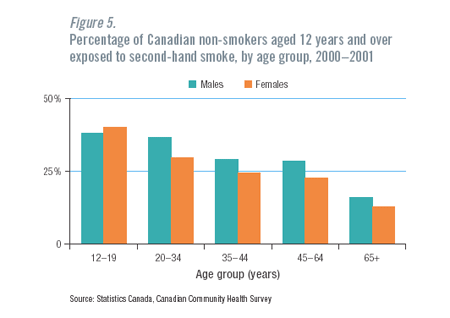
Canadian statistics on second-hand smoke
According to the 2000–2001 Canadian Community Health Survey (CCHS), 28% of Canadians are exposed to second-hand smoke. Exposure varied by age and sex. The highest exposure occurred among individuals aged 12 to 19 (Figure 5). Except for the youngest age group, males reported higher rates of exposure than females. Exposure to second-hand smoke also varied across the country. The highest rates of exposure to second-hand smoke were reported in the N.W.T. (46%) and the lowest rates in British Columbia (18%) (Figure 6). Labelling on Canadian cigarette packages includes warnings of the dangers of exposure to secondhand smoke (Figure 7).
Diet
Current evidence suggests that diet-related factors account for about 30% of all cancers in developed countries. Studies have examined the association between diet and cancer by the types of food consumed (e.g. meat, fruits and vegetables) and by food constituents (e.g. specific vitamins, fibre, fat). Evidence indicates that a diet high in fruits and vegetables reduces the risk of several types of cancer, particularly cancers of the gastrointestinal tract (mouth, pharynx, esophagus, stomach, colon and rectum).
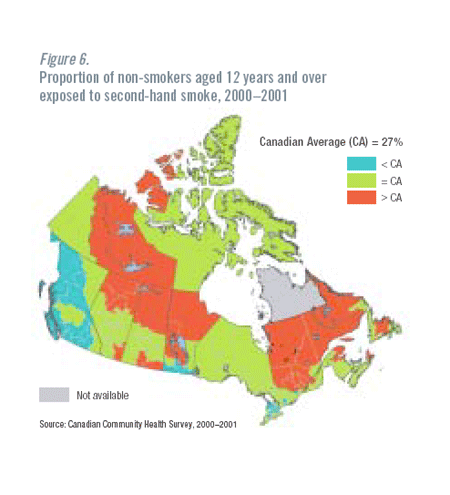

The effect of specific food constituents such as fibre and anti-oxidant vitamins (or their precursors, such as beta-carotene) on cancer risk is still unclear. Meat consumption has been linked to higher rates of colon and some other cancers. Other factors, such as obesity, physical inactivity, and low fruit and vegetable consumption, also play a role.
The role of fat intake
There has been much debate on the role of fat intake in cancer risk. A recent review concludes that other dietary measures, such as increasing consumption of fruits, vegetables and whole grains and decreasing consumption of red meat, may be more effective in decreasing the risk of breast, colorectal and possibly prostate cancer than decreasing total fat intake. The types of fat consumed may also be important. The changes in the fat consumption of beef in Canada in the 1980s, along with the downgrading of marbled beef as the highest quality, contributed to a reduction in saturated fat consumption in Canada and may have contributed to declines in colorectal cancer that have occurred since then.

Fruit and vegetable consumption
Internationally, populations are consistently advised to consume a varied diet with ample fruits, vegetables and whole grains in an effort to reduce cancer risks. The Canadian Food Guide currently recommends 5 to 10 servings of fruits and vegetables daily. According to the 2000–2001 CCHS, more than 60% of Canadians consume less than the recommended daily amount. Fruit and vegetable consumption varied across the country, with the lowest consumption in the North West Territories (72% consumed less than recommended) and the highest in Quebec (although 55%, or the majority of the population, still consumes less than recommended) (Figure 8).
Fruit and vegetable consumption also varies with sex and age (Figure 9). Across all age groups, men consistently eat fewer servings of fruits and vegetables per day than women. While the majority of Canadians aged 20 to 54 ate less than the recommended daily amount, consumption of fruits and vegetables increased gradually among men and women over the age of 55.
The 1998–1999 NPHS showed differences in the diet preferences among men and women. When making food choices, women were more likely to consider overall health, weight and specific diseases. Eighty percent of women were concerned about maintaining or improving health through food choice, compared with 63% of men. While 59% of women considered their weight when selecting foods, just 41% of men did so.
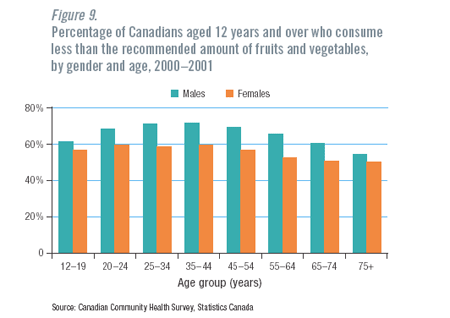
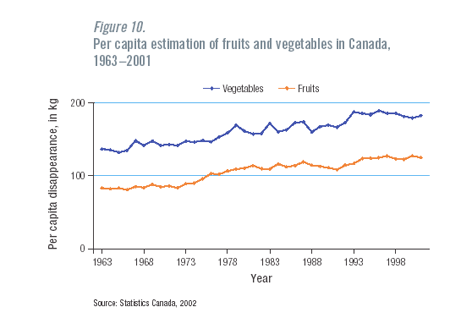
Consumption of fruits and vegetables was also higher among people in the middle to upper income categories and among those with postsecondary education. Eating fruits and vegetables was also associated with other health-promoting behaviours, including physical activity and not smoking.
Since the early 1960s, consumption of fruits and vegetables in Canada has steadily increased. Statistics Canada, which estimates the amount of food available per capita for human consumption, has estimated that Canadians ate, on average, 137 kg of fruits and 84 kg of vegetables annually in 1963. By 2001, these numbers had increased by almost 40% to 183 kg of fruits and 125 kg of vegetables (Figure 10). These changes in diet have probably contributed to the reduction in risk of some cancers. The best evidence for this is the decline in the last decade of cancers of the gastrointestinal tract, such as colorectal cancer (Figures 3, 4, 7, 8 in the Introduction). Larger declines in colorectal cancer among women may also reflect their increasing use of hormone replacement therapy.
Physical activity
The benefits of exercise
Physical activity reduces the risk of colon and breast cancer and possibly of cancer of the endometrium (uterus) and prostate. Studies have demonstrated a 40% reduced risk of colon cancer with high levels of physical activity and a 30% to 40% reduced risk of breast cancer among the most physically active women. A 20% to 40% reduction in the risk of uterine cancer has been noted in some studies of physically active women, and a 10% to 30% reduction in the risk of prostate cancer has been noted in some studies of physically active men.

Rates of physical inactivity
According to the 2000–2001 CCHS, over half of all Canadians aged 12 years or older are considered physically inactive. The highest levels of physical inactivity were reported in the Atlantic Provinces and Quebec (Figure 11). Women have consistently been classified as more physically inactive (54%) than men (44%), but inactivity rates have been gradually declining in both sexes since 1994 (Figure 12). Levels of physical inactivity increase with increasing age (Figure 13). The most active members of the Canadian population surveyed in the CCHS are children aged 12 to 14 years: only 20% reported being inactive. As with adults, boys are more active than girls. By the age of 25, 50% of Canadians were classified as physically inactive.
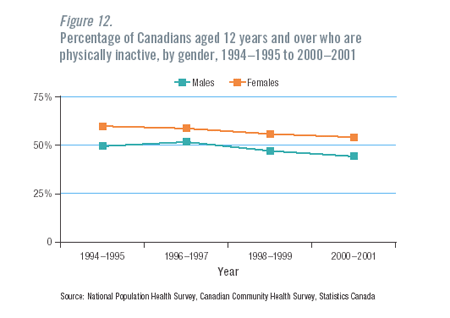
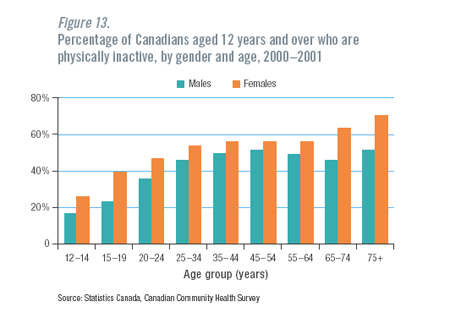
Factors influencing physical activity
Findings from the NPHS indicate that Canadians’ involvement in physical activity is influenced by a complex range of environmental, social and psychological factors, including socio-economic status, level of education and family responsibilities. Research has revealed that workplace, community and mass-media physical activity programs have only modest success, and the effects are rarely long term. In spite of the introduction of nationwide fitness programs designed to promote physical activity, a majority of Canadians remain inactive.
Obesity
The International Agency for Research on Cancer estimates that being overweight or obese accounts for over 25% of colon, endometrial, kidney, esophageal and postmenopausal breast cancer cases worldwide. One way to determine whether an individual is overweight is to calculate his or her Body Mass Index (BMI): weight in kilogram divided by height in metres squared. According to international standards, adults with BMIs ranging from 25.0 to 29.9 are considered overweight and those with BMIs at 30.0 or higher are obese. It is, however, possible to be too thin for full health. The standard for an acceptable weight is a BMI of 18.5–24.9.
High BMIs are associated with an increased risk of colon cancer. Several studies have reported that colon cancer risk for obese individuals is nearly double that of individuals of normal weight. Heavier women are also at increased risk of endometrial cancer and breast cancer in their postmenopausal years. There is an association between renal cell cancer and obesity: obese individuals have twice the risk of developing this form of kidney cancer compared to those at an acceptable weight. An increased risk of esophageal adenocarcinoma has also been linked with obesity. The incidence of this type of cancer has increased by more than 350% since the mid-1970s, an increase that has been attributed to obesity and the associated gastro-esophageal reflux (heartburn).
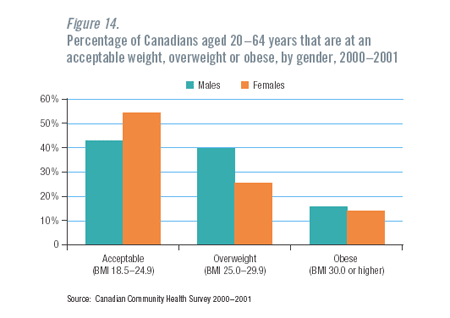

Obesity among Canadians
Estimates from the CCHS show that almost 50% of Canadians are at an unhealthy weight. In the 2000–2001 survey, 47.5% of Canadians were considered to be overweight and, of these, almost a third, or 15% of the total population, were obese. More men (56%) than women (39%) were overweight (Figure 14). Data from the CCHS also indicate that there are currently 2.8 million obese Canadians aged 20 to 64, an estimated increase of 532,000 since 1994 (Figure 15).
The highest percentage of overweight Canadians live in the Atlantic Provinces, where 55% to 60% of individuals aged 20 to 64 are overweight or obese. Populations in the North West Territories and Nunavut are also among the heaviest in the country. The lowest percentages of overweight or obese Canadians are found in British Columbia (42%) and Quebec (44%). Further, there is an increase in the percentage of overweight or obese Canadians with increasing age (Figure 16). There are more overweight or obese males than females for all age groups. The greatest prevalence of obesity, however, is among those aged 45 to 54; 25% of all obese Canadians fall into this age group.

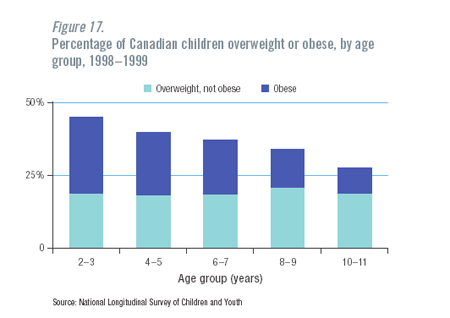
Obesity among Canadian children
Obesity rates are also increasing among Canadian children. According to the National Longitudinal Survey of Children and Youth, 37% of Canadian children aged 2 to 11 were considered overweight in 1998–1999, and 18% were obese.
This represents a considerable increase since 1981, when 18% of children were overweight and only 5% were obese. Younger children (age 2 to 5) were more likely to be obese than older children (age 8 to 11) (Figure 17). While overweight children had activity levels similar to children with normal weights, the activity levels of obese children were considerably lower. Research also indicates that higher proportions of obese children live in low-income families.
Alcohol consumption
Alcohol consumption increases the risk of many types of cancer. Consuming 25 grams of alcohol per day, the equivalent of two standard drinks, increases the risk of mouth, pharynx, larynx and esophageal cancers, predominantly in those who also smoke heavily. Heavy alcohol consumption causes cirrhosis of the liver and, consequently, an increased risk of liver cancer. There is also evidence linking alcohol consumption to breast cancer in women and colorectal cancer, especially in men. There is also some evidence linking alcohol consumption to stomach cancer. In all these cancers, the risk increases with the amount of alcohol consumed.
Information on alcohol consumption among Canadians was collected during the CCHS (2000–2001) and the NPHS (1994–1995 to 1998–1999). Results from these surveys indicate that men consume more alcohol than women at all ages, and that the highest levels of consumption occurred among males aged 20 to 24 years and 65 to 74 years, and women aged 65 to 74 years (data not shown). The survey assessed the frequency of heavy drinking among current drinkers. Heavy drinking was defined as five or more drinks consumed on one occasion, 12 or more times per year. The prevalence of excessive alcohol intake varied across Canada. In 2000–2001, the frequency of heavy drinking was highest in the three Territories, Newfoundland and Nova Scotia, and the lowest levels were found in Ontario, British Columbia and Quebec (Figure 18).

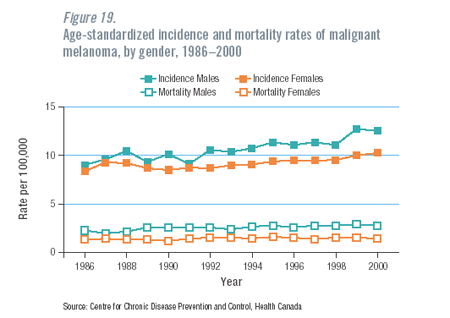
Sun exposure
Skin cancer is the most common form of cancer in Canada. The majority of skin cancer cases are the non-lethal forms: basal cell cancer and squamous cell cancer. The least common and most serious form of skin cancer is melanoma. The incidence of melanoma is on the increase among both men and women (Figure 19). In 2000, there were 3,752 new cases and 709 deaths due to melanoma in Canada.
The primary factor that increases the risk of all skin cancers is excessive exposure to ultraviolet (UV) radiation. The most common source of UV radiation is the sun, although artificial sources such as tanning lamps and beds also produce UV radiation. A recent study concluded that these tanning devices also increase the incidence of non-melanoma skin cancer.
Individuals at particular risk of skin cancer are those with fair to light skin colour, a family history of skin cancer and a history of sunburns. Research suggests that there may be a link between childhood sunburn(s) and melanoma in adulthood. According to the 1996 National Sun Exposure Survey, 50% of adults reported being sunburned at least once during the summer months. Also, parents reported that 50% of children aged 12 or less spent more than two hours in the sun each day during the summer months and that at least 45% of children had been sunburned during that time.
The 1996 National Sun Exposure Survey examined the sun exposure of Canadians at leisure from June to August. It reported that 32% of the individuals surveyed reported staying in the sun for one to two hours, and 28% reported exposures of two hours or more. The remaining 40% reported exposure to the sun for less than one hour.
In this survey, information was also collected on the sun protection habits of Canadians at leisure. In most cases, women were more likely than men to adopt sun safety measures (Figure 20). The prevalence of most sun protection behaviours increased with age. Individuals aged 15 to 24 spent the most time in the sun and rarely used sun protection practices. The only exception with the age association was sunscreen use. Individuals over the age of 65 reported rarely using sunscreen on their face (60%) or their body (71%).
Preventing skin cancer
Skin cancer is a largely preventable disease when sun protective practices are used. The Canadian Dermatology Association and the Canadian Cancer Society recommend six actions for sun safety: avoid the sun between 11 a.m. and 4 p.m., seek shade, wear a hat, wear sun protection clothes, use sunscreen and wear sunglasses.
However, sunscreens should not be used to prolong sun exposure. It is important to educate all people, especially the young, about the risk of prolonged sun exposure and encourage them to develop healthy sun behaviours, concentrating on sun avoidance and wearing of sun-protection clothes. It is also important to recognize the need to provide shade in school playgrounds and other recreational areas.
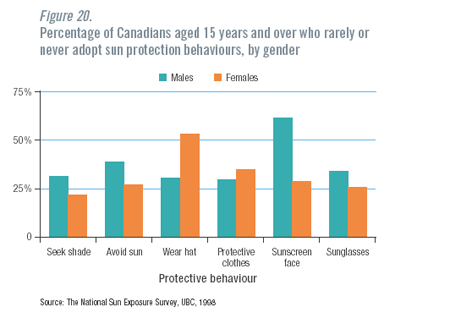
Making progress in prevention
Impacts from positive changes in some modifiable risk factors (e.g. smoking and diet) are already being seen in Canada, especially in relation to reduction of lung cancer in men and reduction of colorectal cancer in both men and women.
Current efforts to encourage further healthy changes in diet and physical activity include:
- the development of a national chronic disease primary prevention plan by the Chronic Disease Prevention Alliance of Canada;
- the planned implementation by the Canadian Strategy for Cancer Control of a primary prevention system at the national, provincial/ territorial and community levels to address population-based risk factors for cancer; and
- the development by the Healthy Living Strategy of comprehensive strategies to encourage healthy eating, physical activity and healthy weights.
The Healthy Living Strategy
The Healthy Living Strategy is a Pan-Canadian effort by the Federal, Provincial and Territorial departments of Health to positively influence the diet and physical activity levels of Canadians. Strategic directions include leadership and public policy development, knowledge development and transfer, community development and infrastructure, and public information.
One advantage of the Healthy Living Strategy compared with previous efforts to influence diet and physical activity is its comprehensive approach. This approach reflects an increasing recognition that a multisectoral “preventive dose” of policy and program activity is necessary to achieve a meaningful impact on the prevalence of risk factors for cancer and other chronic diseases, and on the disease patterns associated with them.
Future challenges
Drawing on lessons learned
The successes achieved in tobacco control have come only after almost four decades of public health interventions involving a wide variety of public health activities, such as social marketing (health promotion), taxation and regulations restricting tobacco use and how it is marketed, together with the expenditure of hundreds of millions of dollars. The current epidemic of obesity resulting from poor diets and physical inactivity has been decades in the making. Efforts to control this epidemic will need to draw upon the lessons learned from tobacco control and will need to be equally comprehensive.
At a recent national symposium on cancer prevention sponsored by the Canadian Strategy on Cancer Control, the following prevention challenges were raised:
- ensuring that surveillance organizations give proper attention to risk factor surveillance and that research-granting agencies give appropriate attention to prevention research;
- facilitating the progress of practices that require infrastructure and capacity building support in communities across Canada;
- promoting prevention through public and media advocacy; and
- linking communities with prevention practices.
A key message of the Canadian Strategy on Cancer Control is that preventive action now, based on sound research and clinical observation, will help reduce the incidence of cancer among Canadians in coming years. The Strategy also recognizes that effective prevention measures will require Canadians to embrace disease prevention and health promotion as a societal value.
Smoking cessation
- It is essential that major efforts continue to be made to persuade smokers to quit while they are young, since the longer a person smokes the greater the risk of lung and other cancers.
- In Canada, the majority of cases of lung cancer in males are now occurring in former smokers and not current smokers. Smoking cessation should continue to be promoted at all ages, as, even at older ages, cessation prevents further increases in risk of cancer and may have a more immediate impact on lowering the risk of other chronic diseases (especially heart disease).
Attention to diet
While fruit and vegetable consumption has been increasing, more emphasis needs to be placed on consumption of whole fruits and vegetables (rather than juices or dietary supplements) and increasing daily consumption to recommended levels of 5 to 10 servings per day.
Addressing obesity
Excessive body weight among children is associated with increased risk of being overweight as an adult, suggesting that obesity will continue to be an important health issue in Canada over the next several decades.
Given the strong links between obesity and increased cancer risk (and other chronic diseases), health policy initiatives aimed at cancer prevention must include changes in the physical and social environment that will support, promote and reinforce changes in behaviour that lead to healthier lifestyle choices.
[Previous] [Table of Contents] [Next]
